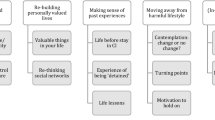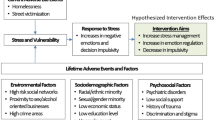Abstract
The purpose of this study was to introduce mindfulness meditation, a recommended adjunctive treatment for trauma in juvenile justice-involved youth, to incarcerated young women and collect narrative commentary about their experiences to answer the following research questions: What is the experience of incarcerated young women who participate in Internet-based mindfulness meditation classes? How do incarcerated young women apply mindfulness meditation to life in a juvenile justice facility? Participants attended bi-weekly guided meditation sessions and wrote about their experiences after each session in a journal. Three coders used open-coding content analysis to identify topics and themes across 38 journal entries. The primary theme, found in 61% of entries, described the difficulties of living in a juvenile justice facility, providing context for the descriptions found in 58% of entries regarding the usefulness of mindfulness meditation to cope with those difficulties. This study highlights the challenges of living in a correctional institution as a young woman and the barriers such settings pose to the wellbeing and healthy development of their residents. It also points to mindfulness meditation as an operative method of supporting these highly traumatized young women until that time when alternatives to incarceration can be identified.
Similar content being viewed by others
References
Akos, P., & Ellis, C. (2008). Racial identity development in middle school: A case for school counselor individual and systemic intervention. Journal of Counseling & Development, 86, 26–32.
Anda, R., Felitti, V., Bremner, D., Walker, J., Whitfield, C., Perry, B., et al. (2006). The enduring effects of abuse and related adverse experiences in childhood. European Archives of Psychiatry and Clinical Neuroscience, 256, 174–186.
Baglivio, M., Epps, N., Swartz, K., Sayedul, M., Sheer, A., & Hardt, N. (2014). The prevalence of Adverse Childhood Experiences (ACE) in the lives of juvenile offenders. Journal of Juvenile Justice, 3, 1–23.
Beck, A., Harrison, P., & Guerino, P. (2010). Sexual Victimization in Juvenile Facilities Reported by Youth, 2008–2009.” Available online: www.bjs.gov/content/pub/pdf/svjfry09.pdf (Accessed on 9 October 2011).
Bennett, K., & Dorjee, D. (2016). The impact of a mindfulness-based stress reduction course (MBSR) on well-being and academic attainment of sixth-form students. Mindfulness, 7(1), 105–114.
Biegel, G., Brown, K., Shapiro, S., & Schubert, C. (2009). Mindfulness-based stress reduction for the treatment of adolescent psychiatric outpatients: A randomized clinical trial. Journal of Community and Clinical Psychology, 77, 855–866.
Bjerk, D. (2007). Measuring the relationship between youth criminal participation and household economic resources. Journal of Quantitative Criminology, 23, 23–39.
Bowen, S., Witkiewitz, K., Dilworth, T., Chawla, N., Simpson, T., Ostafin, B., Larimer, M., Blume, A., Parks, G., & Marlatt, A. (2006). Mindfulness meditation and substance abuse in an incarcerated population. Psychology of Addictive Behavior, 2, 343–347.
Broderick, P. (2005). Mindfulness and coping with dysphoric mood: Contrasts with rumination and distraction. Cognitive Therapy and Research, 29, 501–510.
Burke, C. (2010). Mindfulness-based approaches with children and adolescents: A preliminary review of current research in an emergent field. Journal of Child and Family Studies, 19, 133–144.
Carlson, K. T. (2006). Poverty and youth violence exposure: Experiences in rural communities. Children & Schools, 28, 87–96.
Casement, M., Keenan, K., Hipwell, A., Guyer, A., & Forbes, E. (2016). Neural reward processing mediates the relationship between insomnia symptoms and depression in adolescence. Sleep, 39(2), 439–447.
Casey, B., Tottenham, N., Liston, C., & Durston, S. (2005). Imaging the developing brain: What have we learned about cognitive development? Trends in Cognitive Sciences, 9, 104–110.
Casey, B., Getz, S., & Galvan, A. (2008). The adolescent brain. Developmental Review, 28, 62–77.
Chan, K., & Wan, E. (2012). How can stressed employees deliver better customer service? The underlying self-regulation depletion mechanism. Journal of Marketing, 76, 119–137.
Chiesa, A., Serretti, A., & Jakobsen, J. (2013). Mindfulness: Top-down or bottom-up emotion regulation strategy? Clinical Psychology Review, 33, 82–96.
Clinkinbeard, S., Simi, P., Evans, M., & Anderson, A. (2011). Sleep and delinquency: Does the amount of sleep matter? Journal of Youth and Adolescence, 40, 916–930.
Derezotes, D. (2000). Evaluation of yoga and meditation training with adolescent sex offenders. Child and Adolescent Social Work Journal, 17, 97–113.
Ditto, B., Eclache, M., & Goldman, N. (2006). Short-term autonomic and cardiovascular effects of mindfulness body scan meditation. Annals of Behavioral Medicine, 32, 227–234.
Duke, N., Pettingell, S., McMorris, B., & Borowsky, I. (2010). Adolescent violence perpetration: Associations with multiple types of adverse childhood experiences. Pediatrics, 125, e778–e787.
Ernst, M., Pine, D., & Hardin, M. (2005). Triadic model of neurobiology of motivated behavior in adolescence. Psychological Medicine, 36, 299-312.
Evans-Chase, M. (2013). Internet-based mindfulness meditation and self-regulation: A randomized trial with juvenile justice involved youth. OJUVENILE JUSTICEDP Journal of Juvenile Justice, 3, 63–79.
Evans-Chase, M. (2014). Addressing trauma and psychosocial development in juvenile justice involved youth: A synthesis of developmental neuroscience, juvenile justice, and trauma literatures. Laws, 3(4), 744–758.
Evans-Chase, M. (2015). If they like it they can take it with them: A mixed methods look at the use of Internet-based instruction of mindfulness meditation with incarcerated youth. Advances in Social Work, 16, 90–106.
Fareri, D., Martin, L., & Delgado, M. (2008). Reward-related processing in the human brain: Developmental considerations. Development and Psychopathology, 20, 1191–1211.
Giorgio, A., Watkins, K., Chadwick, M., James, S., Winmill, L., Douaud, G., DeStefano, N., Matthews, P., Smith, S., Johansen-Berg, H., & James, A. (2010). Longitudinal changes in grey and white matter during adolescence. NeuroImage, 49, 94–103.
Goyal, et al. (2014). Meditation programs for psychological stress and well-being: A systematic review and meta-analysis. JAMA Internal Medicine, 174, 357–368.
Greeson, J. (2009). Mindfulness research update: 2008. Complementary Health Practice Review, 14, 10–18.
Hasler, B., Soehner, A., & Clark, D. (2015). Sleep and circadian contributions to adolescent alcohol use disorder. Alcohol, 49, 377–387.
Hayman, B., Wilkes, I., & Jackson, D. (2002). Journaling: Identification of challenges and reflection on strategies. Nurse Researcher, 19, 27–31.
Holzel, B., Ott, U., Hempel, H., Hackl, A., Wolf, K., Stark, R., & Vaitl, D. (2007). Differential engagement of anterior cingulated and adjacent medial frontal cortex in adept meditators and non-meditators. Neuroscience Letters, 421, 16–21.
Holzel, B., Carmody, J., Vangel, M., Congleton, C., Yerramsetti, S., Gard, T., & Lazar, S. (2011). Mindfulness practice leads to increase in regional brain matter density. Psychiatric Research: Neuroimaging, 191, 36–43.
Hsieh, H., & Shannon, S. E. (2005). Three approaches to qualitative content analysis. Qualitative Health Research, 15, 1277–1288.
Jain, S., Shapiro, S., Swanick, S., Roesch, S., Mills, P., Bell, I., & Schwartz, G. (2007). A randomized controlled trial of mindfulness meditation versus relaxation training: Effects on distress, positive states of mind, rumination and distraction. Annals of Behavioral Medicine, 33, 11–21.
Kemper, K., Lynn, J., & Mahan, J. (2015). What is the impact of on-line training of mind-body skills? Journal of Evidence-Based Complementary & Alternative Medicine, 20, 275–282. https://doi.org/10.1177/2156587215580882.
Landau, R. (2008). Social work research ethics: Dual roles and boundary issues. Families in Society: The Journal of Contemporary Social Services, 89(4), 571–577.
Leve, L., Chamberlain, P., & Kim, H. (2015). Risks, outcomes, and evidence-based interventions for girls in the US juvenile justice system. Clinical Child and Family Psychology Review, 18, 252–279.
Levenson, J., Baglivio, M., Wolff, K., Epps, N., Royall, W., Gomez, K., & Kaplan, D. (2017). You learn what you live: Prevalence of childhood adversity in the lives of juveniles arrested for sexual offenses. Advances in Social Work, 18, 313–334.
Levine, N. (2005). Dharma Punx. San Francisco: Harper SanFrancisco, A Division of HarperCollins Publisher.
Manzoni, G., Pagnini, F., Castelnuovo, G., & Molinari, E. (2008). Relaxation training for anxiety: A ten- years systematic review with meta-analysis. British Medical Central Psychiatry, 8, 41–53.
Martires, J., & Zeidler, M. (2015). The value of mindfulness meditation in the treatment of insomnia. Current Opinion in Pulmonary Medicine, 21, 547–552.
Meldrum, R., Barnes, J., & Hay, C. (2015). Sleep deprivation, low self-control, and delinquency: A test of the strength model of self-control. Journal of Youth and Adolescence, 44, 465–477.
Morgan, D. (2007). Paradigms lost and pragmatism regained: Methodological implications of combining qualitative and quantitative methods. Journal of Mixed Methods Research, 1, 48–76.
Nakkula, M., & Toshalis, E. (2010). Understanding youth: Adolescent development for educators. Cambridge, MA: Harvard Education Press.
Nelson, E., Leibenluft, E., McClure, E., & Pine, D. (2005). The social re-orientation of adolescence: A neuroscience perspective on the process and its relation to psychopathology. Psychological Medicine, 35, 163–174.
Padget, D. (1998). Qualitative methods in social work research. Thousand Oaks: Sage Publications.
Paradis, E. (2000). Feminist and community psychology ethics in research with homeless women. American Journal of Community Psychology, 28(6), 839–858.
Park, J. M., Metraux, S., & Culhane, D. P. (2005). Childhood out-of- home placement and dynamics of public shelter utiliza- tion among young homeless adults. Children and Youth Services Review, 27(5), 533–546.
Pilcher, J., Morris, D., Donnelly, J, & Feigl, H. (2015). Interactions between sleep habits and self control. Frontiers in Human Neuroscience, 9, 1–5.
Roberts, R., Roberts, C., & Duong, H. (2008). Sleepless in adolescence: Prospective data on sleep deprivation, health and functioning. Journal of Adolescence, 32, 1045–1057.
Rossa, K., Smith, S., Allan, A., & Sullivan, K. (2014). The effects of sleep restriction on executive inhibitory control and affect in young adults. Journal of Adolescent Health, 55, 287–292.
Sedlak, A., McPherson, K., & Basena, M. (2013). Conditions of Confinement: Findings from the Survey of Youth in Residential Placement. OJUVENILE JUSTICEDP Juvenile Justice Bulletin Available online: http://www.ncjrs.gov/pdffiles1/ojuvenilejusticedp/227729.pdf (Accessed on 4 June 2014).
Snyder, H., & Sickmund, M. (2006). Juvenile offenders & victims: 2006 national report. Washington, DC: U.S. Department of Justice, Office of Justice Programs, Office of Juvenile Justice and Delinquency Prevention. Retrieved from http://www.ojuvenilejusticedp.gov/ojstatbb/nr2006/downloads/nr2006.pdf.
Tang, Y., Lu, Q., Fan, M., Yang, Y., & Posner, M. (2012). Mechanisms of white matter changes induced by meditation. Proceedings of the National Academy of Sciences, 109(26), 10570–10574.
Teplin, L. A., Abram, K. M., McClelland, G. M., Dulcan, M. K., & Mericle, A. A. (2002). Psychiatric disorders in youth in juvenile detention. Archives of General Psychiatry, 59, 1133–1143.
Winters, D., & Beerbower, E. (2017). Mindfulness and meditation as an adjunctive treatment for adolescents involved in the juvenile justice system: Is repairing the brain and nervous system possible? Social Work in Healthcare, 56, 1–22.
Author information
Authors and Affiliations
Corresponding author
Ethics declarations
Conflict of Interest
On behalf of all authors, the corresponding author states that there is no conflict of interest.
Ethical Standards and Informed Consent
All study procedures were approved by the Rowan University Institutional Review Board and the state-level Juvenile Justice Commission Research Review Board. Additional informed consent was obtained from all individuals for whom identifying information is included in this article.
Additional information
Publisher’s Note
Springer Nature remains neutral with regard to jurisdictional claims in published maps and institutional affiliations.
Rights and permissions
About this article
Cite this article
Evans-Chase, M., Kornmann, R., Litts, C. et al. #freemind: Young Women Using Mindfulness Meditation to Cope with Life in a Juvenile Justice Institution. Journ Child Adol Trauma 12, 377–385 (2019). https://doi.org/10.1007/s40653-018-0245-5
Published:
Issue Date:
DOI: https://doi.org/10.1007/s40653-018-0245-5




